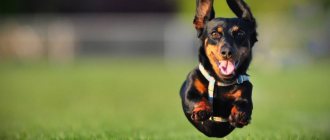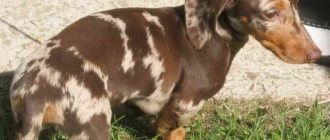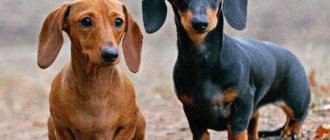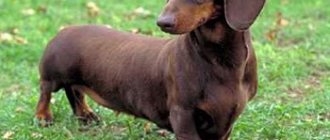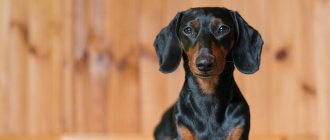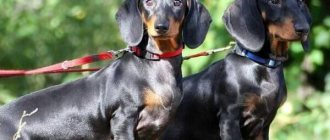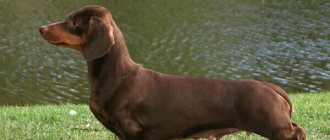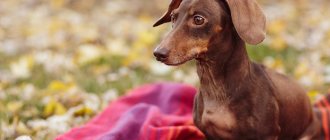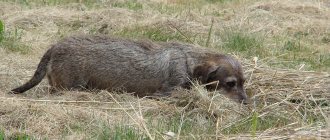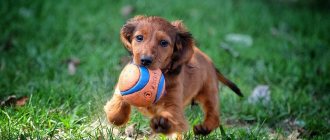Perhaps the most recognizable city dog is the smooth-haired Dachshund. Small dimensions and ease of care make the breed practically ideal for apartment living. Dachshunds get along well with children, learn quickly and adapt to the owner's pace of life. An ideal dog for home and hunting, naturally, with appropriate care and education.
Historical reference
The standard smooth-haired dachshund is the oldest variety of the breed , having ideal inclinations for burrow hunting. As many years of experience have shown, four-legged animals successfully learn how to drive animals and various sports as an alternative to hunting.
The history of the breed lasts more than 5 thousand years. Squat dachshund-type dogs were used for hunting and protecting homes from rodents . From the early canids came two varieties of hunting dogs: the larger Bracques and the compact Dachshunds. There is also an intermediate type - the dachshund brakk.
Despite the fact that the remains of dachshund dogs have been found in different countries, Germany is recognized as their homeland . For the Germans, burrow hunting has always had a special meaning; it ensured survival, protection of food supplies and small farm animals. With the development of progress, hunting has become a tradition and an indicator of status.
The first description of the breed was compiled in Germany. The breed club, created in 1988, took on the difficult job of systematizing the requirements for dogs. After the adoption of the international standard, the popularity of Dachshunds increased sharply, and this did not happen due to fashion. The active export of dogs has led to the fact that the Dachshund is recognizable all over the world. In Germany, the breed is in second place in popularity; the German Shepherd is still the undisputed leader.
After settling around the world, dogs began to transform to the requirements of a specific territory. By selecting small dogs for breeding work, the smooth-haired miniature dachshund (dwarf) was obtained. Quadrupeds with a narrowed chest did not get stuck in holes and could hunt in complex holes. Later, the smooth-haired rabbit dachshund appeared, which is often perceived as a decorative apartment breed.
Character traits
Despite their very modest size and frivolous appearance, these are by no means decorative animals. They are characterized by self-confidence, independence and even stubbornness. They will not tolerate rudeness or disrespect and use all available means to assert their “I”. Therefore, both the standard and miniature smooth-haired dachshund will become an excellent companion only for those who can properly build a relationship with it.
Do not forget: these are born hunters, which leaves an imprint on the character and behavior of the dog. Representatives of this breed are characterized by such qualities as fearlessness, ingenuity and the ability to make independent decisions. It is the latter that causes frequent complaints from owners about the disobedience of their pets.
Appearance
Probably every dog lover knows what a Dachshund looks like, but not everyone knows that there are certain requirements for the physique of this breed. Regardless of size, the four-legged animal must be fit, muscular, without folds of skin or excess weight.
Note! The smooth-haired dwarf dachshund is a medium-sized variety, and the smallest is the rabbit variety.
A standard size gradation (height, weight) is not applied to Dachshunds; when assessing, the expert relies on:
- Chest circumference: more than 36 cm for standard; 30–35 cm is the norm for dwarf; up to 30 cm for rabbit. The measurements are valid for dogs older than 15 months.
- Weight: about 9 kg, 3–4 kg, 2.5–3 kg respectively. A dog weighing more than 9 kg can be recognized as a purebred dog, but cannot receive an “excellent” rating.
Breed standard
The standard defines the breed according to 2 characteristics - size and coat.
By size:
- standard;
- dwarf;
- rabbit
By wool type:
- smooth-haired;
- long-haired;
- wire-haired.
There are 9 combinations of these characteristics. For example, a long-haired standard dachshund, a royal purebred, a dwarf smooth-haired or a wire-haired rabbit.
In most breeds, small representatives are not included separately in the standard . Sometimes too small a size or long hair, on the contrary, are recognized as defects at exhibitions.
This is the main difference between the standard for dachshunds - the approved sizes and type of coat.
Character and training
Dachshunds are very energetic, and at a young age they are also unexpectedly playful. Growing up, the dog loses interest in games, but not in excitement. Even if a dog has never been trained to hunt, it instinctively pays attention to smells and, if desired, follows them. Being carried away by the search for prey, the pet may not hear your commands, or even run away from you on purpose. When walking in unfamiliar areas, even in the company of other dogs, the four-legged dog must be on a leash. The same recommendation applies to the rutting period if your pet is not spayed/sterilized.
Important! Do not let your Dachshund off the leash if you are not sure of its control!
Representatives of the breed are attached to the owner and tolerant of other family members. Children have a special position and are forgiven for their pranks. Whether the Dachshund will be friends with other animals is an individual indicator. According to the experience of owners, they get along well with cats if the owner follows the rules of gradual training. In relation to strangers, dogs are more distrustful than friendly. The dachshund cannot be used to guard the house, but if necessary, it will protect the family (especially if we are talking about a child).
Representatives of the breed are very smart. Training must begin from a very early age. You should approach training comprehensively and familiarize your pet with a wide range of commands in a short time. Dachshunds are not prone to favors; they like partnership and respect. Interpersonal contact and attention of the owner play a very important role in training.
Note! Dachshunds love when people talk to them, they listen carefully and seem to understand perfectly well what is being said.
The dachshund is a purely hunting dog that needs work or its alternative . If you have a pet as a companion and pet, be prepared for long walks, active games or sports. The stress associated with jumping must be strictly controlled, especially important for older dogs.
Black genetic color
A black dachshund is obtained if a combination of atatBB or atatBb occurs at the genetic level, while the second dog latently has a genetic brown pigment. At - tan color, B - black pigment in the genotype, b - brown pigment. If two red dogs were mated, then a black and tan dachshund may be born. On the one hand, this seems funny, but even if a blue tan dachshund (with the atatBBdd genotype) was mated with a brown tan, the result may also be a black dog. Two-colored dogs are smooth-haired and long-haired, and in this group of dogs there may be a black and brown dachshund. Dogs have brown eyes, with dark tones visible in the lower part of the muzzle. A black dog has a black nose and claws.
If the dog has white spots, then the dachshund is considered a defect; small marks are quite acceptable. The black dachshund has a clear outline of the head, it is elongated and narrowed towards the nose. If there is the presence of black melanin, the coat is shiny and rich in color. A pure black dachshund belongs to a variety of non-standard colors, if it is without tan, its genotype is BK- and bbK, where K represents the development of a single-color tone from the eumelanin group, more often girls are born under this genotype. According to the system of the International and Russian Cynological Federation FCI-RKF, a dog is entered into a breeding marriage in Russia, and their breeding is not carried out, but if a dog is born, it becomes loved, just as it is. The American Kennel Club (AKC) for breeding purebred dogs is the club where the black color of dachshunds is officially acceptable for breeding.
Health
With an average life expectancy of 12–15 years, the Dachshund is prone to a number of diseases. You need to understand that the breed is of an advanced age, which increases the risk of detecting expected and purely genetic ailments:
- Swimmer's syndrome in puppies leads to the fact that babies cannot stand on their paws and move by crawling. The pathology develops rapidly and in most cases (with timely assistance) is successfully stopped.
- Pinching of the spinal nerves due to displacement of the spinal discs leads to paralysis of the hind limbs. Most often, the disease manifests itself in old age.
- Dysplasia is also common in older dogs .
- Formation of rough folds of skin with darkened pigmentation or papillary pigmentary dystrophy of the skin.
Dachshunds can suffer from cataracts and glaucoma. Dogs kept on low-quality industrial food are almost guaranteed to develop urolithiasis or kidney failure. At a young age, Dachshunds may be diagnosed with diabetes. The condition does not resolve completely and the pet remains dependent on insulin injections for life.
Important! Dachshunds, like any other pets, need to be vaccinated against viruses! It is recommended to vaccinate working dogs against piroplasmosis.
Obesity is a common ailment for all types of Dachshunds. The development is caused by an unbalanced diet, lack of exercise or hormonal imbalances. With frequent bathing and food allergies, the dog suffers from skin diseases (eczema, seborrhea).
Smooth-haired Dachshunds are prone to hypothermia and colds in frosty and rainy weather. Problems can be prevented with warm and protective clothing. Dogs with black coloring run the risk of overheating in hot weather, and this can be prevented by wearing a white T-shirt on your pet and moving the walk to less hot hours.
Photo of what it looks like
Standard individuals are easily recognizable.
These are short-legged, elongated dogs, with a proudly set head and floppy ears. Dachshunds are strong and muscular.
Mobile, despite the ratio of paw length to body length. They have a decisive and confident appearance.
There are no concessions for dwarf and rabbit dachshunds . They are characterized by the same breed appearance.
Photo
File Catalog
FCI Dachshund BREED STANDARDCountry of origin: Germany.
The original of the current standard was published on March 13, 2001 Scope of application: Hunting dog for working in a hole and on the surface of the earth. FCI Classification: Group 4 - Dachshunds. (With working tests.)
Brief historical background: The Dachshund (other breed names are Dackel, Teckel, Dachshund) has been known since the Middle Ages. In the group of hounds (*bracks*), dogs were constantly bred, especially suitable for working underground. These low-legged dogs gave rise to the Dachshund breed, which has become recognized as one of the most versatile and useful hunting dog breeds. The dachshund also showed itself excellently in working on the surface of the earth - in hunting *with a voice*, as well as in working on a blood trail. The oldest club involved in breeding dachshunds is the *German Dachshund Club* (Deutsche Teckelklub e. V.), founded in 1888. For decades, Dachshunds have been bred into three varieties based on size (Dachshund, Miniature Dachshund, and Rabbit Dachshund) and coat quality (Smooth-haired, Long-haired, and Wire-haired).
General appearance: Squat, short-legged dog, elongated but compact in build, very muscular, with a bold, defiant carriage of the head and a wary expression. Sexual dimorphism is pronounced (the general appearance corresponds to the sexual type). Despite the fact that the dachshund's legs are very short relative to the length of the body, the dog retains mobility and flexibility.
Proportions: The distance from the bottom of the chest to the ground is about 1/3 of the height at the withers. The length of the body is in harmony with the height of the dog; the ratio of the height at the withers to the length of the body is approximately 1:1.7-1.8.
Behavior and Temperament: Friendly by nature, no nervousness or aggressiveness, with a balanced temperament. In work - a passionate, persistent (viscous), fast and tireless hunting dog with excellent scent.
Head: Viewed from above and in profile, elongated. Tapers evenly towards the nose, but is not pointed. The brow ridges are clearly defined. The nasal cartilage and dorsum of the nose are long and narrow. Skull: Quite flat, gradually giving way to a slightly arched bridge of the nose. The transition from the forehead to the muzzle is only indicated. Nose with a well-developed lobe. The muzzle is long, quite wide and powerful. The mouth can open wide, reaching eye level. The lips are close fitting, covering the lower teeth well. Jaws and teeth: The upper and lower jaws are well developed. A scissor bite, with evenly spaced teeth and a strong grip. Ideally, a full set of 42 teeth, with powerful, tightly closed fangs. Eyes: Medium size, oval shaped, widely spaced, with a clear, energetic but friendly expression. The gaze is not piercing. Eye color is bright, from dark red-brown to black-brown, regardless of color. White, *fishy* or *pearly* eyes in merle dogs are undesirable, but acceptable.
Ears: Set high, not too far forward. Enough, but not excessively long. Rounded, not narrow, not pointed or folded. Movable. The front edges of the ears fit tightly to the cheekbones.
Neck: Quite long and muscular. The skin on the throat fits tightly. Slightly arched scruff. The neck is held free and high.
BODY: Topline: Smooth and harmonious from neck to slightly sloping croup. Withers: Pronounced. Back: The part of the topline, starting behind the high withers from the thoracic vertebra, is straight or slopes slightly towards the croup. Strong, with well-developed muscles. Loin: Well-muscled, fairly long. Croup: Wide and fairly long. Slightly inclined. Chest: The sternum is well developed and carried forward so much that small depressions form on each side of it. When viewed from the front, the chest is oval in shape. When viewed from above or from the side, it appears spacious enough for the development of the heart and lungs. The ribs are well laid back. With the correct length and setness of the scapula and shoulder, when viewed in profile, the front leg covers the lowest point of the sternum. Underline and belly: The belly is slightly tucked in. The tail is not set too high and is kept level with the topline (as its continuation). A slight bend in the last third of the tail is allowed.
LIMBS. Forelegs: Short, but so short that the distance from the bottom of the chest to the ground is one third of the height at the withers. As direct as possible. With developed muscles and good articulation angles. When viewed from the front, the forelegs are clearly defined, bony, and set parallel; paws point straight forward. Shoulders with elastic muscles. Long sloping shoulder blade, fitting tightly to the chest. The shoulder is the same length as the shoulder blade and is located almost perpendicular to it. With developed bones and muscles, tightly pressed to the chest, but not constrained in movement. Her elbows are turned out and not brought together. Wrists: Compared to the shoulder joints, somewhat closer together. Pasterns: When viewed from the side, they should be neither vertical nor clearly sloping forward. Feet: Arched, with tightly clenched toes, developed, powerful and elastic pads and short powerful claws. The dewclaw has no functional significance, but should not be removed.
Hindquarters: Very muscular, in proportion to the forelimbs. Strong stifle and hock angles. The position is parallel. The thighs are quite long, with well-developed muscles. The knee joints are wide, powerful, with well-defined angles. The tibiae are short, almost perpendicular to the thighs. With good muscles. The hock joints are well defined and strongly sinewed. The metatarsus are relatively long, mobile relative to the shins. Slightly tilted forward. The feet are arched, with four toes tightly closed. Durable posture, powerful pads.
Movements: should be sweeping, smooth and energetic, the forelimbs should be carried far forward without strong lifting, powerful pushes of the hind limbs impart light springy movements to the back. The tail should be carried as a harmonious extension of the slightly sloping croup. The movements of the front and hind limbs are parallel.
Skin: Tightly fitting.
COAT:
Smooth-haired dachshund
Coat: Short, dense, shiny, close-lying, dense and harsh. No bald spots. Tail: Thin, fully feathered but not too profusely. Slightly elongated guard hair on the lower part of the tail is not a fault.
Color: a) Solid color: Red, reddish-fawn, fawn, black hairs may be scattered throughout the main color. Pure color is preferred; The red color is valued higher than the red-fawn or fawn color. The color is considered solid even with a significant amount of black hair. White markings are undesirable, but small single markings are not a disqualifying fault. The lobe and claws are black. Reddish-brown nails and nose are acceptable, but not desirable. b) Bi-color: Deep black or brown, with tan or fawn markings above the eyes, on the sides of the muzzle and on the lower lip, on the inside surfaces of the ears, on the front of the chest, on the inside and back of the legs, on paws, around the anus (passes to the lower part of the tail, reaches a third or half of it). The nose and claws of black dogs are black, while those of brown dogs are brown. White markings are undesirable, but small single markings are not a disqualifying fault. Too extensive scorch marks are undesirable. c) Marble color (brindle): The background is always dark (black, red or grey). The desired pattern is gray or beige spots of irregular shape (large spots are undesirable). The colors are evenly distributed (neither dark nor light shade predominates). Dachshunds have brindle coloring - dark stripes on a red or fawn background. The nose and claws are the same color as one-color and two-color dachshunds.
Wirehaired dachshund
Coat: With the exception of the muzzle, eyebrows and ears, close-lying, dense, wiry guard hair with undercoat. There is a clearly defined beard on the muzzle. The eyebrows are bushy. The hair on the ears is shorter than on the body, almost smooth. Tail: Well and evenly covered with close-lying hair.
Color: Various shades of boar color predominate (from dark to light), as well as the color of dry leaves. Otherwise, the colors are the same as the smooth-haired dachshund.
Long-haired dachshund
Coat: Glossy, shiny coat with undercoat, lying close to the body. The hair on the throat and lower part of the body is longer. On the ears, the hair should hang over the lower edge of the ear, forming feathering. On the back sides of the limbs there are clearly defined featherings. Reaches its greatest length on the underside of the tail, where it forms a true flag.
Colour: As described for the smooth coated dachshund. Size, weight and important measurements: Miniature dachshund: Chest circumference at the age of not earlier than 15 months is 30-35 cm. Rabbit dachshund: Chest circumference at the age of not earlier than 15 months up to 30 cm. Weight: A standard dachshund weighs no more than 10 kg.
FLAWS
Any deviation from the above requirements is considered a fault and its severity is assessed strictly in proportion to its severity. » Presence or absence of MH (Molar 3) » When judging is not o The absence of PM2 is considered a fault if all other teeth, with the exception of the MH, are present. » Deviation from a correct scissor bite is considered a fault.
VICES:
» Weak torso, high-legged, or torso touching the ground. » Absence of teeth, with the exception of those listed in the sections “Disadvantages” and “Disqualifying Defects”. »White (porcelain) eyes in all colors except marbled. » Pointed and very folded ears. » The body is “suspended” between the shoulders. » Sagging back, “crab back”. » Weak lower back. » Noticeable high hindquarters (croup higher than withers). » Too weak chest. » Groin: greyhound-shaped blast. » Poor angulation of front and rear legs. » Narrow hind legs with insufficient muscles. » Cow-like or barrel-shaped hindquarters. » Paws are noticeably turned in or out. » Loose paws. » Heavy, clumsy or waddling movements.
WOOL DISADVANTAGES:
Smooth-haired dachshund:
» Too thin or sparse coat. Bald patches on the ears or other parts of the dog's body. » Excessively coarse or profuse hair. " Tail. Brush-like. » Partially or completely hairless tail. » Black color without any markings (tan marks).
Wirehaired Dachshund:
» Soft wool, regardless of length. » Long hair extending from the body in all directions. » Curly or wavy coat. » Soft hair on the head. » Flag-shaped tail. » Insufficiently developed beard. » Insufficient volume of undercoat. » Short hair.
Longhaired Dachshund:
» The coat is the same length throughout the body. » Wavy or shaggy coat. » Insufficient tail suspension. » Insufficient feathering on the ears. » Short hair. » Noticeable parting on the back. » Too long hair between the toes.
DISQUALIFYING FAULTS:
» A cowardly or aggressive dog. » Underbite or overbite, misalignment. » Incorrect position of the lower canines. » Missing one or more canines; absence of one or more incisors. » Absence of premolars or molars. Exception: two RM1, one RM2, excluding M3. » Chest: the sternum does not protrude. » Any defect in the structure of the tail. » Very loose in the shoulders. » Kozinets on the front legs. » Black color without marks (tan); white color with or without marks (tan marks). » Any color not provided for in the “Color” section of this standard.
NB: Males must have two apparently normal testes, fully descended into the scrotum.
